
Lord Black praises the work of the Commonwealth War Graves Commission during a speech in the House of Lords as he steps down from the Board of the Imperial War Museum after eight years.
Lord Black of Brentwood (Con): My Lords, I join others in congratulating my noble friend on securing this poignant debate. I, too, concur with everything that he said. I declare my interest as a trustee of the Imperial War Museum, a post I hold, sadly, for only another eight days, when those baleful words “term limit” strike.
As we have heard today, the work of the commission is vital because there can be no more visible symbol of loss, sacrifice and courage than the cemeteries it maintains. Following on from the point made by my noble friend Lord Tugendhat, its work has always been based on one very fundamental principle originally outlined by Sir Frederic Kenyon in his report a century ago for the new Imperial War Graves Commission on the different approaches that might be taken to commemoration—that of equality. It matters not what rank you were or how you fell: all are treated the same in the eternity of those remarkable cemeteries.
As a trustee of the IWM, I would like to thank the commission for its effective partnership with us. We have worked incredibly well together in the nearly 100 years since we were both formed in 1917. We shared a beginning and share as much today. Together we have helped bring together all the dimensions of remembrance for the nation through, most recently, the First World War centenary to VE Day and beyond. Indeed, the commission is in so many ways a model of how to make effective partnerships work. The IWM is just one of the many organisations it works with. Other partners exist in veterans’ organisations, battlefield tours and in many museums across the globe—from the Juno Beach Centre in France to the Thai Burma Railway Centre.
One of the key areas of partnership is in photographic services. These have been crucial to the act of commemoration since the British Government first started getting requests for photos of graves at the height of the fighting in World War I. By 1917, 17,000 requests for photographs of graves had been filed. Today the War Graves Photographic Project continues that work. Over the years it has issued 1.6 million photos, allowing many to share in seeing the resting place of a family member even if they cannot visit I would also like to pay tribute to the work the commission has done in supporting the IWM’s Lives of the First World War digital project and working tirelessly on joint educational projects.
The commission has an excellent website, as the noble Lord, Lord Shipley, said, and Discover 14-18 is a key part of the centenary commemorations. It all began last August and will continue until November 2018, allowing a new digital generation to learn the lessons of conflict.
A young soldier called John William Streets died on the first day of the Battle of the Somme, aged 31. He had hoped to become a poet after the war but all he could do was write poetry in the trenches. He wrote one poem with a good deal of foresight about the cemeteries that would one day criss-cross northern Europe and so much of the rest of the globe. He wrote:
“When war shall cease this lonely unknown spot; Of many a pilgrimage will be the end, And flowers will shine in this now barren plot; And fame upon it through the years descend”.
Long may the Commonwealth War Graves Commission, whose important work we celebrate today, ensure that the fame of the fallen continues to shine on those cemeteries.
Hansard source: http://www.publications.parliament.uk/pa/ld201516/ldhansrd/text/150622-…
